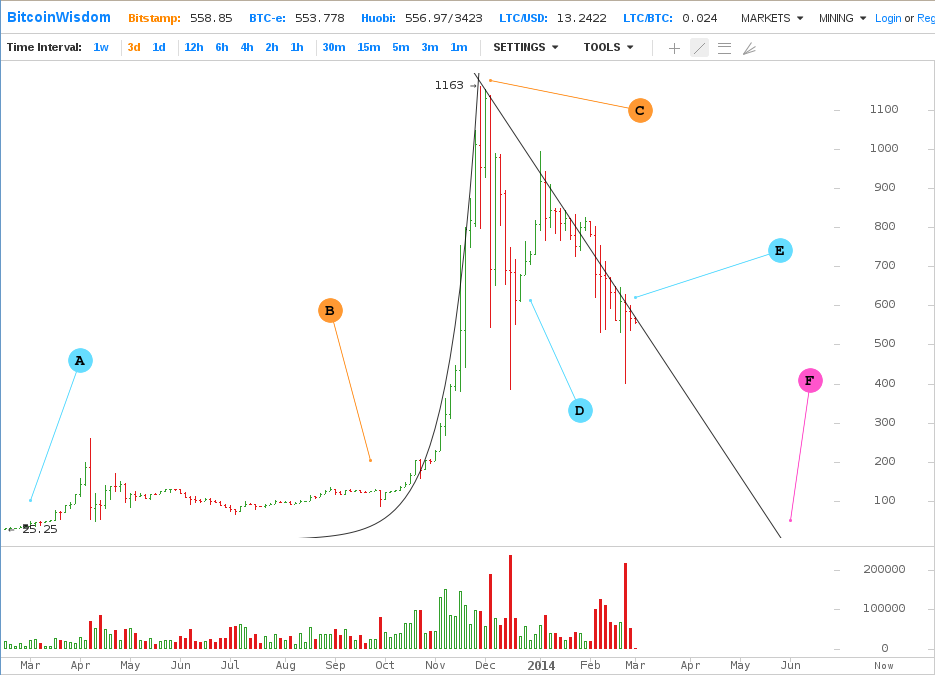
Jorge Stolfi
March 02, 2014
Last edited on 2014-03-02 17:04:52 by stolfi
In this note it is argued that, quantitatively, there were only two significant events in the history of bitcoin: the expansion of the Chinese market, mainly in October--November 2013, and its partial closure by the Chinese government, in early December 2014.
Considering the way the market appears to be evolving, unless there is some new significant development comparable to those two, bitcoin may be dead by the middle of 2014.
See the price chart below (adapted from the site Bitconwisdom).

A Initial expansion of the Chinese bitcoin market (Hong Kong).
B Expansion of the bitcoin market in mainland China (Beijing).
C Chinese government bans use of bitcoin in commerce and finance.
D Chinese exchanges adapt to the new government regulations.
E Collapse of the main bitcoin exchange outside China (MtGOX, Japan).
F Death of bitcoin?
A In April 2013 the price of bitcoin rose exponentially from about 20 USD to 200 USD, then partially collapsed, settled down to about 100 USD, and remained there until the end of September. The cause of the April rally is disputed, but it is probably due, at least in part, to expansion of the user base of the BTC-China exchange in Hong Kong.
B Another exponential increase in the price occurred through October and November 2013, from around 100 USD to a peak of about 1100 USD on Nov/29. That rally apparently was due to the expansion of the bitcoin market in mainland China, at the new exchanges Huobi and OKCoin in Beijing, that (unlike the earlier ones) charged no transaction fees.
C In early december the Chinese government, through its central bank (PBoC), issued decrees that severely restricted the use of bitcoin in China. Banks and financial institutions were barred from dealing with bitcoins. The use of bitcoin for payments was banned, as well as the quoting prices in bitcoin. E-commerce sites were prohibited from selling bitcoins in any form, and e-payment services were prohibited to send money to bitcoin exchanges. Although some of these bans had a Feb/01 deadline, many sites hurried to comply with them well before that. The price in all exchanges fell abruptly, reaching to 1/3 to 1/2 of its peak value over the next couple of weeks.
D In the weeks following the PBoC decrees, the Chinese exchanges scrambled to find workarounds. Eventually, Huobi and OKCoin found that they could still operate by restricting deposits and withdrawals to the national currency (Yuan, CNY) and only through Chinese banks. Those developments caused the price to recover gradually, so that by January 2014 it had stabilized around 800 USD. However, in early February it started a gradual decline, which appears to be still going on.
E At the end of February, MtGOX, the oldest and most popular bitcoin exchange outside China, suddenly closed, confessing to the loss of 800,000 BTC that belonged to investors. In spite of the huge losses (more than 400 million dollars at current prices) and the extensive media coverage, that event does not appear to have had a significant influence in the price of bitcoin.
F Looking for trends in price charts is a non-scientific actvity (known by technical analysis in stock trading jargon) whose "conclusions" often result only from our genetic predisposition to see patterns even in totally random data.
With that caveat, the maximum daily BTC prices after Feb/06 (and, in fact, since the peak of Nov/29) seem to lie very close to a straight line. The mean daily prices too give a similar trend.
A possible explanation for that trend could be a hypotetical growing disenchantment among speculative investors, including those who lost money in bad trades and those who see little chance of success with prices that do not show signs of a substantial increase in the short term. As investors leave the market, they take their money and leave their coins, thus depressing the price even further. The falling prices presumably also keep new investors away.
Extrapolated, that straight line crosses the zero-price axis around June 2014. Will that be the end of bitcoin?
One could also fit those prices with a decaying exponential trend, instead of a straight line. Extrapolation of such a trend would indicate that the price will gradually decrease, without ever reaching zero. However, at some point the low price would make mining unprofitable. In any case, a decreasing price would drive investors away.
Besides, the BTC price at MtGOX (which blocked all withdrawals in early February, thus disconnecting its clients from the rest of the market) fell from 900 USD on Feb/05 to 90 USD on Feb/20, along a straight line, until the exchange shut down completely.